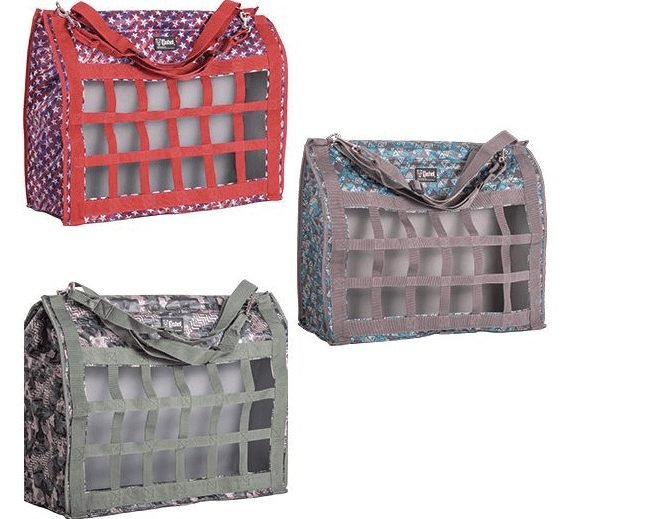Weaver Leather Slow Feed Hay Bag The Weaver Leather Slow Feed Hay Bag is intended to advance more slow feed utilization and advance better processing. Its rugged 600 Denier polyester construction is great for use in stalls and trailers and is designed to help alleviate boredom as well as reduce hay waste. Highlights: Great for use in slows down and trailers Easily swings from movable, separable ties Top-stacking bag holds two average-size flakes of hay Mesh bottom for ventilation Item Specifications
WHY THIS IS BENEFICIAL?
Cashel Hay Bag has a top opening for adding roughage in addition to the front feed opening. This is a top-quality roughage sack that is solid and durable. It’s finished with strong bars at the top, headed creases for added strength, and two lashes on the top and base to hold the sack back from turning. An extreme, solid weave network permits soil and trash to get away, not to gather in the base as is with most sacks of this kind. Holds 3-4 drops of roughage, contingent upon size.
Preliminary Stages
The preliminary stages are the point at which the stowaway/skin is ready for tanning. During the preliminary stages, a considerable lot of the undesirable crude skin parts are eliminated. Numerous choices for pretreatment of the skin exist. Not the entirety of the choices might be performed. Preliminary stages might include:
➤ Protection of the cover-up/skin is treated with a strategy that renders it briefly imputrescible.
➤ Splashing – water for reasons for washing or rehydration is once again introduced.
➤ Liming – undesirable proteins and “opening up” is accomplished.
➤ Unhairing – most of the hair is eliminated.
➤ Fleshing – subcutaneous material is eliminated.
➤ Parting – the stowaway/skin is cut into at least two even layers.
➤ Relining – the stowaway/skin is additionally treated to accomplish more “opening up” or more protein evacuation.
➤ Deliming – liming and unhairing synthetic substances are taken out from the pelt.
➤ Bating – proteolytic proteins are acquainted with the skin to eliminate further proteins and to help with mellowing of the pelt.
➤ Degreasing – regular fats/oils are stripped or as much as is conceivable from the stowaway/skin.
➤ Freezing – the actual evacuation of the fat layer inside the skin. Likewise like Slicking.
➤ Fading – synthetic alteration of dim shades to yield a lighter-hued pelt.
Pickling – bringing of the pH esteem down to the acidic area. Should be done within the sight of salts. Pickling is ordinarily done to assist with the infiltration of certain tanning specialists, e.g., chromium (and different metals), aldehydic, and some polymeric tanning specialists.
➤ Portraying – raising of the pH out of the acidic locale to help with infiltration of certain tanning specialists.
TANNING STAGE
Tanning is the process that converts the protein of the rawhide or skin into a stable material that will not putrefy and is suitable for a wide variety of end applications.
The head distinction between crude covers up and treated leathers are that crude conceals dry out to frame a hard resolute material that can be putrefied when re-wetted (wetted back), while tanned material dries out to a flexible form that does not become putrid when wetted back. An enormous number of various tanning strategies and materials can be utilized; the decision is eventually reliant upon the end use of the calfskin. The most ordinarily utilized tanning material is chromium, which leaves the calfskin when tanned, a light blue tone (because of the chromium), this item is normally called “wet blue.
CRUSTING
Crusting is the point at which the stowaway/skin is diminished, retained, and greased up. Frequently a shading activity is remembered for the crusting sub-measure. The engineered substances added during crusting should be repaired set. The peak of the crusting sub-measure is the drying and progressing exercises. Crusting may incorporate the accompanying activities:
✔️ Wetting back-semi-prepared calfskin is rehydrated.
✔️ Saying – 45-55%(m/m) water is squeezed out the calfskin.
✔️ Parting – the calfskin is parted into at least one level layer.
✔️ Shaving – the calfskin is diminished utilizing a machine that cuts cowhide strands off.
✔️ Balance – the pH of the cowhide is changed in accordance with a worth somewhere in the range of 4.5 and 6.5.
✔️ Retaining – extra tanning specialists are added to give properties.
✔️ Coloring – the calfskin is shaded.
✔️
Fatliquoring – fats/oils and waxes are fixed to the calfskin strands.
✔️ Filing – Substant/thick synthetic compounds that make the calfskin harder and heavier are added.
✔️ Stuffing – fats/oils and waxes are added between the filaments.
Made of 600 denier nylon for enduring solidnessStrong bars at the top make stacking roughage a snap. Two top lashes and a base dee ring hold the sack back from turning The tough double-weave mesh allows dirt and debris to escape. Holds three flakes of hay.
Highlights:
✔️ Make sure this fits by entering your model number.
✔️ Foam girth pad grooved down the center that helps prevent gall sores.
✔️Can be disinfected easily, preventing the spread of girth itch.
✔️Grooved down the center that helps prevent gall sores.
✔️ Size: 4 feet X 3/4 inches thick (cut to fit) foam girth pad.
click here for more interesting articles



























